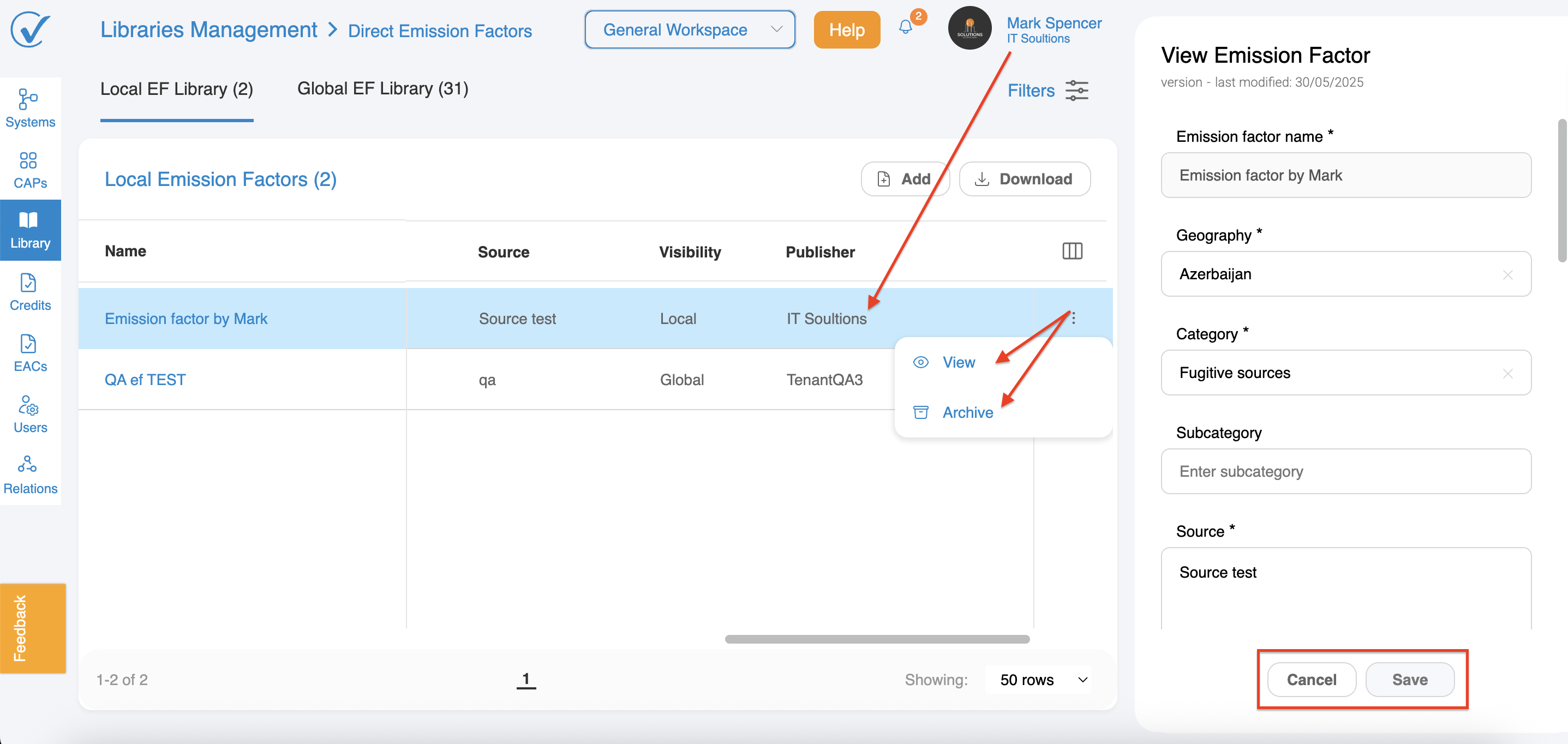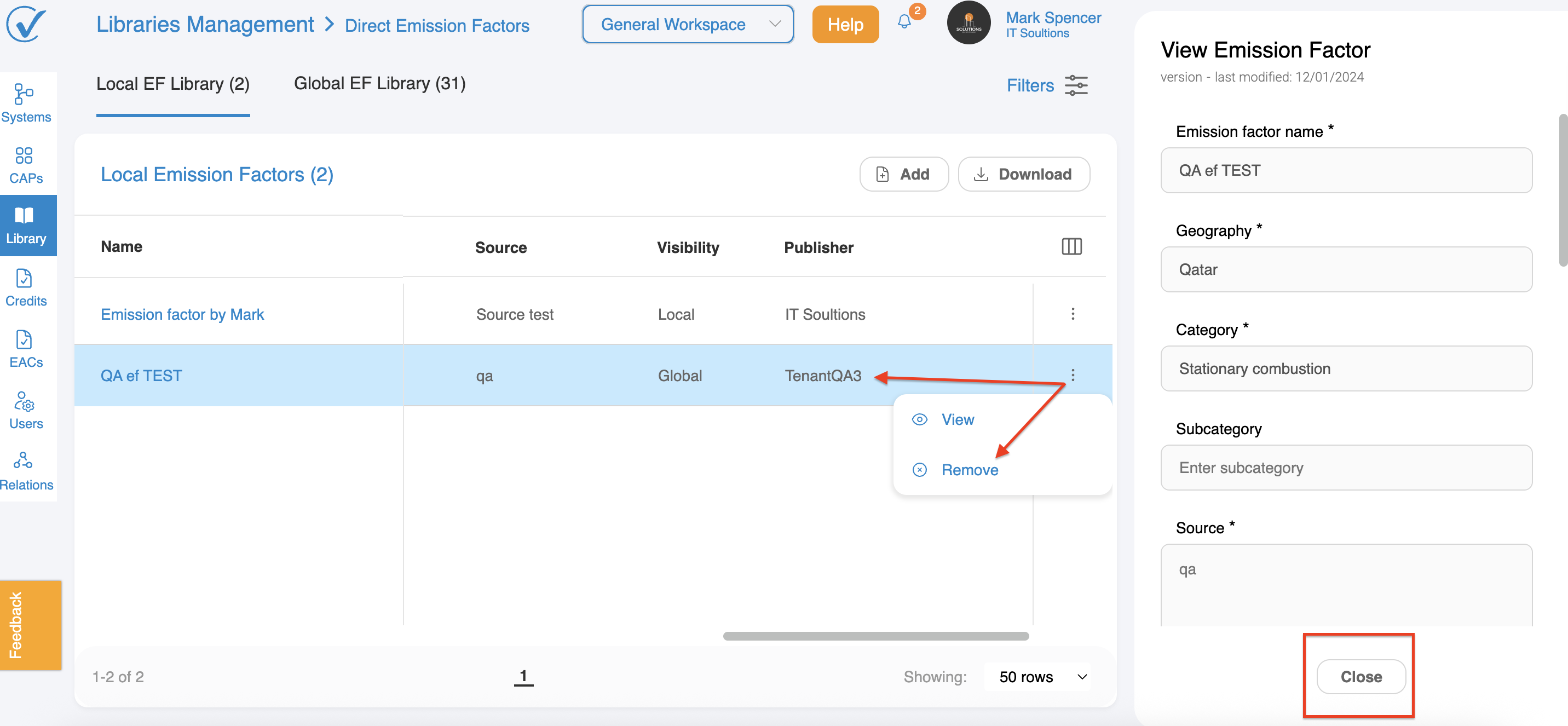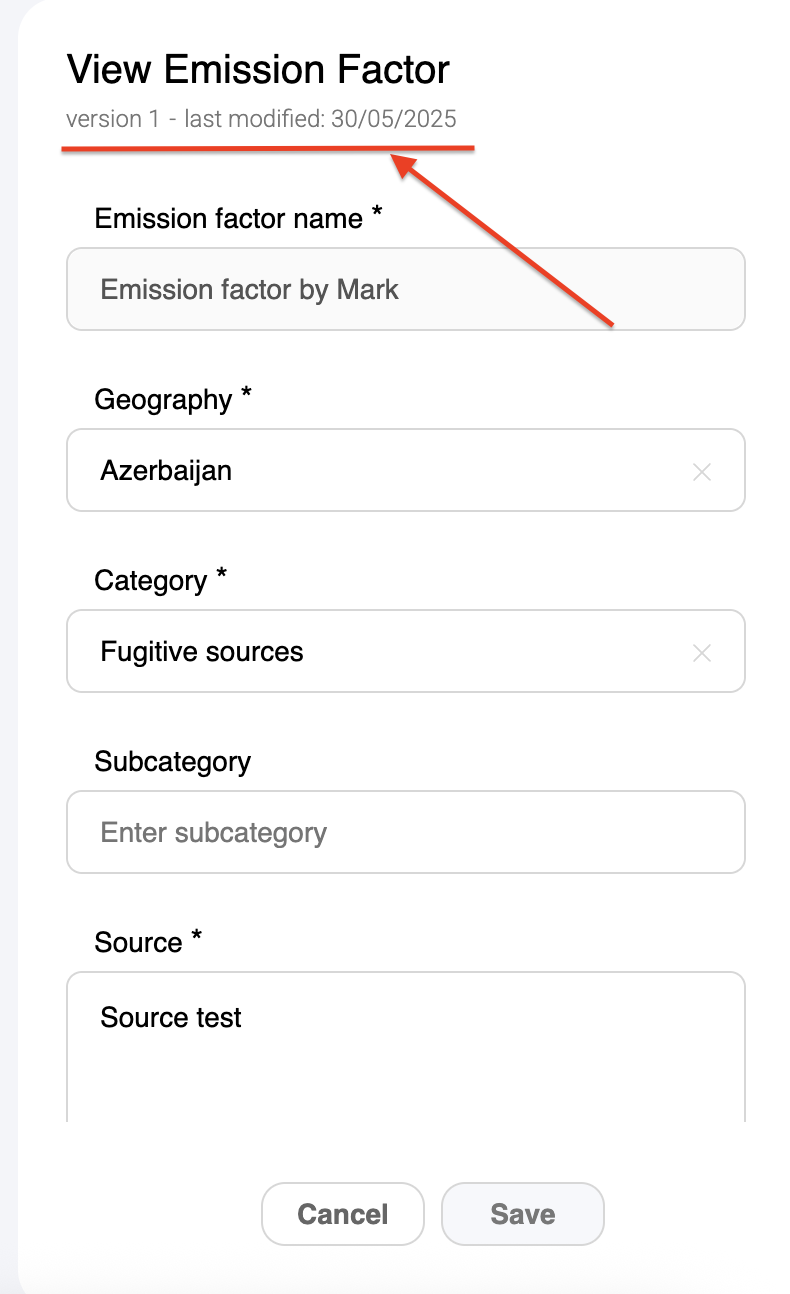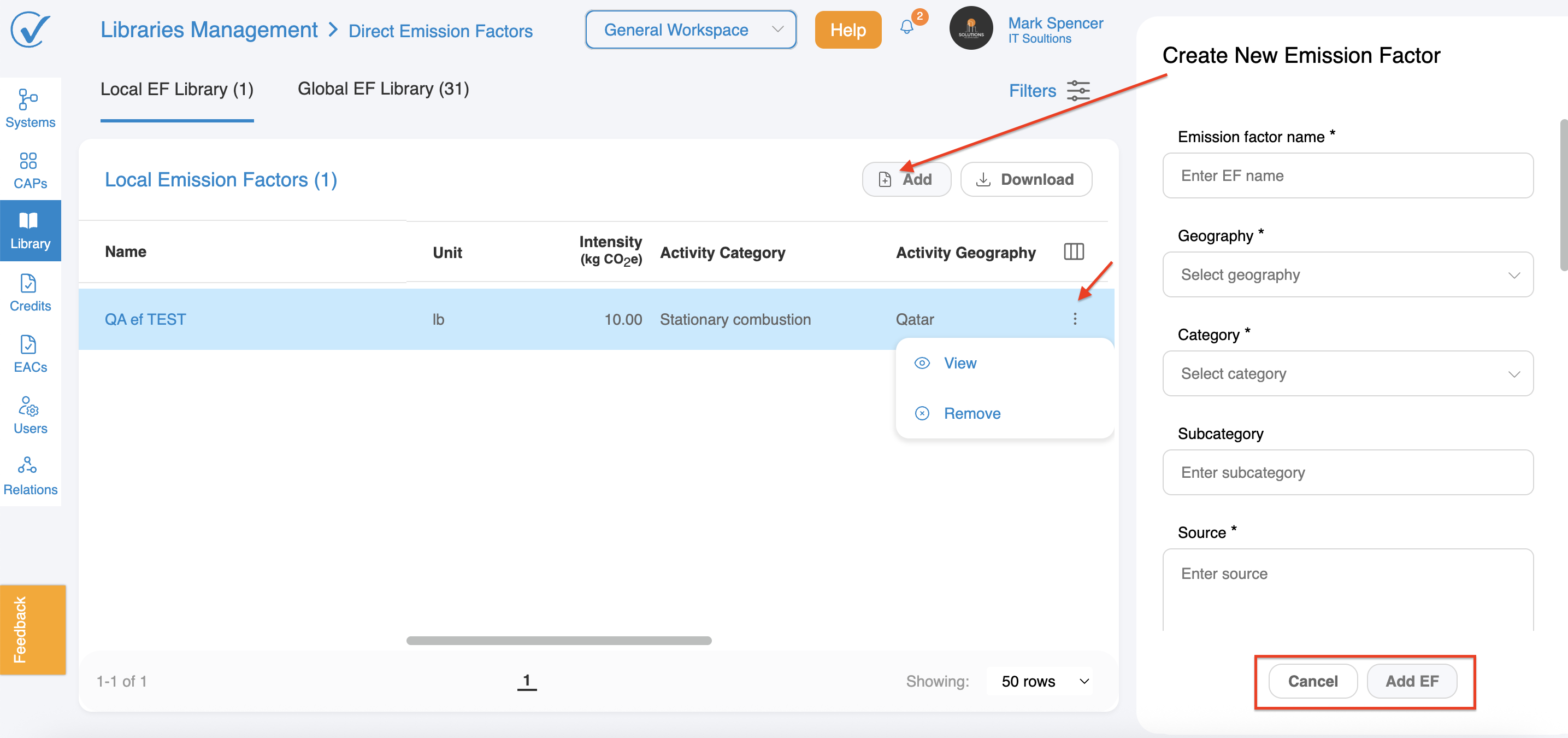Direct Emission Factors
The Emission Factor (EF) Library is your central resource for managing greenhouse gas emission factors in CarbonSig. This feature allows you to create, share, and manage standardized emission factors that can be used directly in process systems for carbon calculations.
Getting Started with EF Library
What is an Emission Factor?
An Emission Factor (EF) is a standardized value that represents the amount of greenhouse gases emitted per unit of activity. EFs are essential for calculating carbon footprints in process systems. Each EF contains:
- Greenhouse gas emission values per unit
- Source documentation
- Activity categories and geography
- Calculation methodology
- Tags for easy searching
Understanding the two EF Libraries
Local EF Library
- Contains EFs specific to your account
- Includes EFs you've created or added from the Global Library
- Allows full management capabilities (create, update, archive)
Global EF Library
- Contains all publicly available EFs in the CarbonSig environment
- Includes EFs from other CarbonSig accounts and third-party databases (e.g., Ecoinvent, SimaPro)
- Searchable repository for finding relevant emission factors

How to Create a New Emission Factor
Before You Begin
- Ensure you have appropriate permissions to create EFs
- Gather emission data from reliable sources
- Prepare calculation methodology documentation
Step-by-Step Guide
- Navigate to Local EFs tab
- Click the "+" icon to open the Add New Emission Factor modal
- Fill in Required Fields: Basic Information
- Emission Factor Name (150 character limit) - Use clear, descriptive names
- Activity Category - Select from dropdown
- Activity Sub-Category (40 character limit) - Optional, for further classification
- Activity Geography - Select the geographic region
- Source (150 character limit) - Cite your data source
- Unit of Measurement - Select appropriate unit (e.g., kg CO2e/kWh)
- Greenhouse Gas Type - Carbon dioxide is added by default
- Amount - Enter the emission factor value
- Buffer - Set uncertainty percentage using slider or direct input
- Click "Add emission type" to include additional greenhouse gases
- Declaration (25000 character limit) - Describe the emission factor and its application
- Calculation Methodology (200 character limit) - Explain how the factor was calculated
- Tags (20 character limit each) - Add searchable keywords, press Enter after each tag
- Upload Document - Attach supporting files (PDF, DOC, DOCX, XLS, XLSX, ODF, JPG, JPEG, PNG)
- Visibility - Choose between:
- Global - Available to all CarbonSig users (default)
- Local - Only available to your account
- Click "Add EF" to save
Tips for Creating Quality EFs
- Use standardized naming conventions
- Include comprehensive source citations
- Add relevant tags for better discoverability
- Document calculation methods clearly
- Set appropriate buffer percentages for uncertainty
Using EFs from the Global Library
Finding Emission Factors
- Navigate to the Global EF Library tab
- Use search and filter options to find relevant EFs
- Use tags to narrow down results
- Review EF details by clicking "View"
Adding EFs to Your Local Library
- Find the desired EF in the Global Library
- Click "Use EF" in the actions menu
- Review the confirmation message showing the EF name
- Click "Use EF" to confirm
- The EF will now appear in your Local EF Library
What Happens When You Use an EF
- The EF is copied to your Local Library
- You can use it in your process systems
- You cannot edit EFs created by other account's user
- The EF remains linked to its original source
Viewing and Managing EFs
Viewing EF Details
Click "View" on any EF to see complete information including:
- All data fields and emission values
- Version information
- Source and methodology
- Tags and documentation
- Attached files
Understanding EF Permissions
If you are the original publisher:
- Can update/edit the EF
- Can archive the EF
- Updates create new versions

If EF is from another account or third-party:
- Can only view details
- Can remove from Local Library
- Cannot edit or archive
- Cannot request updates (unlike LCIs)

Updating EFs and Version Control
Who Can Update EFs?
Only the original publisher of an EF can update it.
How to Update an EF
- Open the EF in View mode
- Click "Update EF"
- All fields become editable
- Make necessary changes
- Click "Save Changes"
Version Control System
- Version 1: Shows "version 1 - created: mm/dd/yyyy"
- Updated versions: Shows "version X - last modified: mm/dd/yyyy"
- All versions are tracked for audit purposes

Important Version Notes
- Previous versions are preserved in the system
- Process systems using the EF automatically use the latest version
- Version history ensures traceability
Removing and Archiving EFs
Remove vs Archive
Remove - Returns EF to Global Library
- Available for EFs from other accounts
- EF is removed from your process systems
- Can be re-added later from Global Library
Archive - Permanently removes from CarbonSig
- Only for EFs you published
- Notifies all accounts using the EF
- Cannot be restored
- Historical data preserved in existing calculations
How to Remove an EF
- Click the three dots menu on the EF
- Select "Remove"
- Review the confirmation message
- Click "Remove" to confirm
How to Archive an EF
- Click the three dots menu on the EF
- Select "Archive"
- Review the warning message
- Check affected process systems (if any)
- Review affected accounts (if any)
- Click "Archive EF" to confirm
Before Archiving Consider:
- All systems templates using the EF will be affected
- Other accounts using the EF will be notified
- Action cannot be undone
- Consider updating instead of archiving if data needs revision
Using EFs in Systems
- Select EFs when building process flows
- EFs provide emission calculations automatically
- Multiple EFs can be used in a single process
- EFs update automatically when publishers make changes
Best Practices
Data Quality
- Use emission factors from reputable sources
- Document all assumptions clearly
- Include appropriate uncertainty buffers
- Keep factors up-to-date with latest research
Organization
- Use consistent naming conventions
- Add relevant tags for searchability
- Select accurate categories and geographies
- Maintain clear documentation
Collaboration
- Share high-quality EFs globally when appropriate
- Keep EFs updated as new data becomes available
- Provide clear methodology documentation
- Consider the impact before archiving shared EFs
Troubleshooting
Common Issues
Cannot create EF
- Verify you have appropriate permissions
- Check all required fields are completed
- Ensure character limits aren't exceeded
- Verify at least one greenhouse gas is added
Cannot find EF
- Check both Local and Global libraries
- Try different search terms or tags
- Verify filters aren't too restrictive
- Confirm the EF hasn't been archived
EF not appearing in process system
- Ensure EF is in your Local Library
- Check that the unit matches your needs
- Verify the EF hasn't been removed
Cannot update EF
- Confirm you are the original publisher
- Check your permissions
- Ensure you're in the View modal
Key Differences from LCIs
Understanding the differences between EFs and LCIs:
- No RFI workflow - EFs cannot be requested or have update requests
- Simpler structure - EFs focus on emission values per activity unit
- Tags for searching - EFs include tags for better discoverability
- Direct application - EFs provide immediate calculations in processes
Need More Help?
If you need additional assistance with Emission Factors or have questions not covered in this guide, please contact our support team support@carbonsig.com or consult the CarbonSig user manual.

